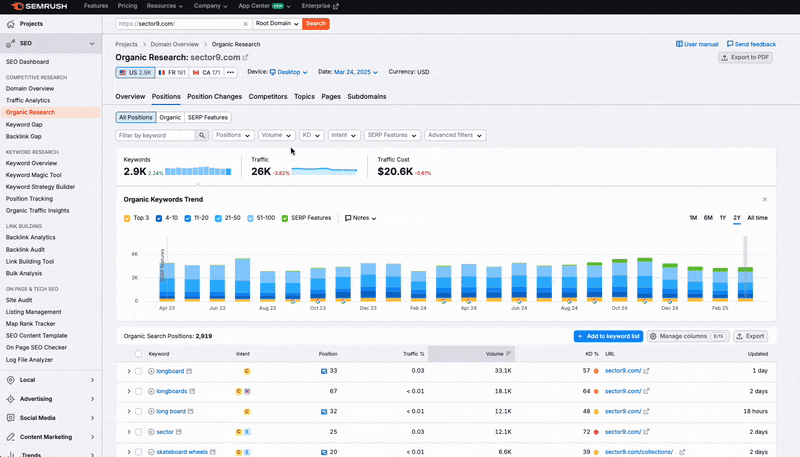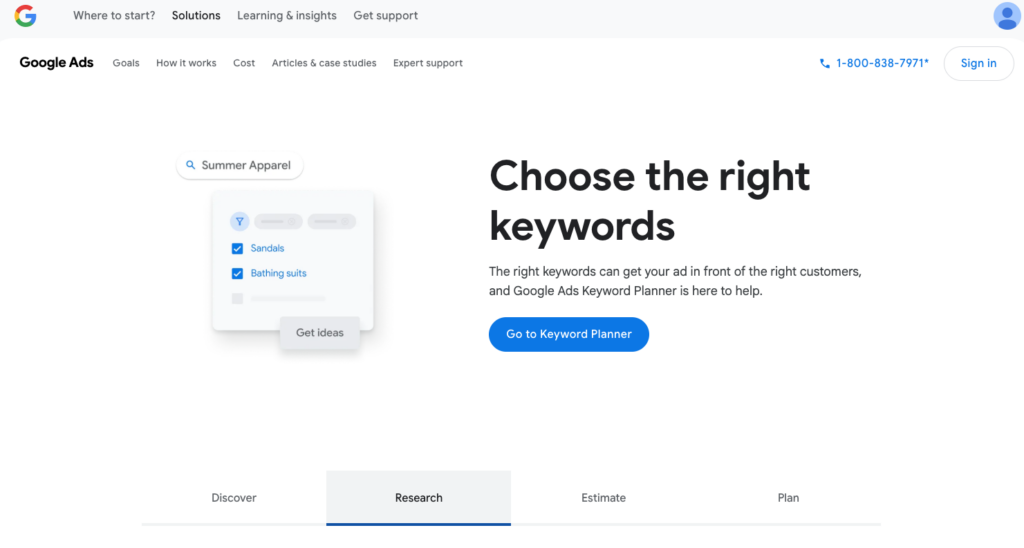SEO Goldmine: Stop Guessing, Start Ranking
The first thing I learned over 15 years ago and the one thing that still remains one of the most important steps in the SEO process is keyword research and keyword mapping. Over the years I’ve honed my process and today I’m going ot share my step-by-step recommendations to getting started on finding the right keywords for your keyword mapping and on-page strategy.
Keyword research is the foundation of SEO success and your keyword mapping process, shaping how businesses attract and convert the right audience. Whether you run an eCommerce store or a B2B company, the approach to keyword strategy differs—eCommerce brands focus on category and product pages, while B2B businesses prioritize service offerings and lead-generation content. Understanding these differences is key to targeting the right search intent and driving meaningful traffic. In this guide, you’ll learn how to prioritize high-impact pages, analyze competitors, and map keywords effectively, ensuring your SEO efforts lead to real business growth.

1. Start with Leveraging Existing Keyword Rankings
Before you start diving into keyword research, you’ll want to look at the rankings you already have and find ways to optimize them further. Analyzing your existing keyword performance allows you to capitalize on current rankings and make incremental improvements to your rankings without starting from scratch. This strategy can lead to quick wins and significant traffic boosts.
Using Semrush Organic Ranking Tools to Find Existing Rankings
One of the most effective ways to uncover current keyword rankings is by using Semrush’s Organic Research SEO tool. By entering your domain, you can see which non-branded keywords your site is already ranking for.
How to Find Existing Rankings with Semrush:
- Enter your domain into Semrush’s “Organic Research” tool.
- Navigate to the “Positions” tab to see a list of all keywords your site ranks for.
- Filter by non-branded keywords (keywords that don’t include your business name) to focus search terms relevant to your industry with high monthly search volume.
- Look at rankings for each keyword and note the positions they hold—especially those in positions 11-20 and all the way up to position 100.

💡 Tip: Non-branded keywords are especially valuable because they show how well you’re ranking for generic search terms, making them key for long-term SEO growth.
Finding Quick-Win Opportunities
When reviewing your existing keyword rankings, pay attention to keywords that are ranking in positions 5-20. These terms are in the “almost there” zone or “striking distance”, meaning with a bit of optimization, they could easily move into the top 10 or top 3, where the most traffic is concentrated.
Why Focus on Keywords in Positions 5-20?
- Minimal Effort, Maximum Reward – A small change can significantly boost rankings.
- High Search Volume – Keywords in these positions still attract a good amount of traffic.
Lower Competition – You’re already competing in this space, so a few tweaks could make a big difference.
💡 Example: If your category page ranks #12 for “best hiking backpacks”, optimizing the content, adding relevant internal links, or improving page speed could push you into the top 5, where traffic potential increases dramatically.
Expanding on Keywords You Already Rank For with Better Content
For keywords you’re already ranking for, you can often gain more visibility by improving your existing content. Rather than creating new pages from scratch, consider expanding on your current high-ranking pages:
- Enhance on-page SEO – Ensure your title tags, meta descriptions, and headings are optimized for the target keyword.
- Optimize for search intent – Ensure your content matches the specific search intent behind the keyword, whether it’s informational, transactional, or commercial.
Example: If your product page ranks well for “lightweight hiking boots”, you could add a section on “how to choose the right lightweight hiking boots” to provide additional value to users and help increase ranking potential.
2. Start with Your Most Important Pages
Select the pages that are a top priority and also have some keyword rankings. If they don’t have keyword rankings, you’ll want to identify your top pages before diving into keyword research. It might seem like a no brainer, but know that it’s crucial to focus on the pages that drive the most revenue and conversions. Prioritizing these high-impact pages ensures that your SEO efforts contribute directly to business growth and organic visibility.
For eCommerce: Prioritizing Category and Product Pages
For eCommerce websites, category and product pages are the most valuable for organic traffic and sales. Instead of optimizing every page at once, focus on:
- Top-selling product pages – Products with high sales potential or profit margins.
- High-traffic category pages – Core product categories with broad search appeal.
- Seasonal or trending items – Pages with fluctuating demand based on trends or holidays.
If you run an online store selling outdoor gear, your “Hiking Boots” category page should be a priority over a niche product like a single pair of socks.
For B2B: Focusing on Core Service and Lead-Gen Pages
For B2B companies, SEO should support lead generation by optimizing pages where potential clients make decisions. These typically include:
- Core service pages – The main offerings your business provides.
- Industry-specific solutions pages – If your services cater to multiple industries, tailor keywords to each.
- Case studies & whitepapers – Supporting content that helps nurture leads.
💡 Example: A B2B SaaS company offering marketing automation software should prioritize a “Marketing Automation Solutions” service page over a blog post about general digital marketing trends.
Don’t Forget Your Top Navigational Pages
Beyond product and service pages, your key navigational pages (homepage, about page, and key category pages) also play a significant role in SEO.
- Homepage – Ensure it’s optimized for branded and core industry keywords.
- Category & Subcategory Pages – These should align with how users search.
- Location & Contact Pages – Crucial for local SEO and trust-building.
💡 Example: You might realize that your “Accessories” category page has low search volume compared to more specific pages like “Phone Cases” or “Laptop Bags.” This could indicate the need to restructure your site or rename a category to align with how users search.
Why This Exercise Helps with Site Structure & Keyword Strategy
By analyzing your top pages, you may find that:
✔ Certain category pages aren’t needed – If no one searches for them, they could be consolidated.
✔ Categories need to be renamed – A more searched-for term may perform better.
✔ Navigation improvements can boost SEO – Ensuring your main pages reflect search demand leads to higher rankings.
How to Identify Which Pages Need Keyword Optimization First
To determine which pages should take priority, analyze:
- Google Analytics & Search Console – Identify pages already bringing in organic traffic.
- Revenue & Conversion Data – Prioritize pages that lead to sales or leads.
- Competitor Rankings – Check which pages competitors rank for and where you can compete.
- Keyword Gaps – Look for important industry terms missing from your key pages.
3. Keyword Mining: Conducting Competitor Research
One of the fastest ways to uncover high-value popular keywords in your vertical, is by analyzing your competitor’s keyword rankings—not just businesses you compete with directly, but those ranking for the same search terms. Competitor research helps you identify keyword opportunities, content gaps, and winning strategies that you can apply to your own site.
Identifying Your True SEO Competitors
Your SEO competitors are the websites ranking for the keywords you want to target—not necessarily the same businesses you see as direct competitors.
💡 Example: A boutique skincare brand may consider a major beauty retailer like Sephora as a business competitor, but in SEO, they might be competing with beauty blogs and niche eCommerce sites that dominate organic search results.
To find your true SEO competitors, search for your core product, category, or service keywords in Google and note which domains consistently appear in the top results.
Using Semrush to Analyze Competitor Keywords
Semrush is an essential tool for competitor research, allowing you to:
✔ Find the keywords your competitors rank for
✔ Identify high-ranking pages driving their organic traffic
✔ Spot keyword gaps—terms they rank for that you don’t
How to Analyze a Competitor’s Keyword Strategy in Semrush:
- Enter a competitor’s domain into Semrush’s “Organic Research” tool.
- View their top-ranking pages and see which keywords drive traffic.
- Look for high-volume, low-difficulty keywords that align with your business.
- Check the “Keyword Gap” tool to compare your rankings against competitors and uncover missed opportunities.
💡 Example: If a competing outdoor gear store ranks well for “best waterproof hiking boots” and you don’t, this could be a great long-tail keyword to target on your product or category pages.
Finding High-Ranking Competitor Pages & Keyword Gaps
Instead of just looking at individual keywords, analyze which competitor pages perform best and why.
- Look at their top-ranking product or service pages. Are they structured differently? Do they have better on-page SEO elements?
- Identify content gaps. Are there questions, features, or benefits they include that you don’t?
By understanding which keywords and pages drive your competitors’ success, you can refine your own strategy and create better-optimized, more competitive content.
Reverse-Engineering Competitor Success for Your Site
Once you’ve gathered competitor insights, apply them strategically:
- Prioritize keywords with high traffic and lower competition.
- Improve page structure and content depth. If a competitor’s category page ranks well, analyze how they use internal linking, product descriptions, and FAQs.
- Create content that fills keyword gaps. If competitors rank for an important industry term you’re missing, develop a dedicated page targeting that query.
- Optimize for search intent. Look at the types of content ranking (product pages, guides, comparisons) and align your strategy accordingly.
By leveraging competitor keyword research in Semrush, you can outperform competitors in organic search while ensuring your site ranks for the most valuable terms in your industry.
4. Researching Keywords for Your Main Pages
Keyword research is about driving revenue, not just rankings. Here’s how to target the right keywords for your key pages:
For eCommerce: Focus on Category, Product, and Brand Keywords
- Category Keywords: Attract traffic with broad terms like “women’s running shoes.”
- Product Keywords: Go specific—target terms like “Nike Air Zoom Pegasus 39” for buyers ready to purchase.
- Brand Keywords: Rank for high-demand brand terms like “Adidas hiking boots” to target shoppers who know what they want.
These keywords ensure you’re visible where it matters—when customers are ready to buy.
For B2B: Target High-Intent Service and Solution Keywords
- Service Keywords: Use terms like “CRM software for marketing automation” to attract high-intent leads.
- Solution-Based Queries: Address pain points with keywords like “how to increase sales with email automation.”
These keywords bring in qualified leads ready to solve problems with your services.
Use Google’s Tools for Fast Insights
- Autocomplete or Google Suggest: See real-time search suggestions to spot keyword opportunities based on popular searches within Google. Google will automatically have keyword suggestions offered up in real-time in a drop down.
- People Also Ask (PAA): Find keyword suggestions in the PAA box in the Google search results. There you’ll find related popular keywords related to the search query you are targeting.
- Related Searches: Use terms at the bottom of the Google page results to expand your keyword list.
Using these free seo tools help you quickly identify valuable, low-competition keyword ideas.
Leverage Customer Pain Points and FAQs
- Pain Points: Keywords like “back pain relief” help target customers with specific needs.
- FAQs: Turn customer questions into high-ranking, conversion-driving content.
By focusing on customer needs and high-intent keywords, you’ll attract qualified traffic and drive more sales.
5. Expanding Your Keyword List with Additional Research
Your initial keyword list is just the beginning. To supercharge your SEO, expand it with long-tail keywords, seasonal trends, and deeper insights that give you a competitive edge.
Finding Long-Tail Variations for Niche Opportunities
Long-tail keywords are your secret weapon. These more specific, lower-competition phrases (like “best waterproof hiking boots for women”) not only have less competition, but they also attract highly-targeted traffic. Dig into your core search terms and brainstorm relevant variations that address niche needs and unique search intents. These keywords may not drive massive traffic, but they often have higher conversion rates.
Identifying Seasonal Trends and Shifts in Demand
SEO isn’t static—consumer demand shifts seasonally, and you can leverage that. Use keyword tools to spot seasonal variations in searches (like “summer hiking gear” or “Black Friday sales”). Knowing these trends allows you to create targeted content ahead of time, capturing traffic at its peak and ensuring you stay ahead of competitors.
Use Semrush’s Keyword Research Tool or Google’s Keyword Planner
Semrush and Google Keyword Planner are indispensable keyword research tools that help you build on your keyword list.
Here’s how:
- Semrush Keyword Magic Tool: Enter your target keyword and explore related terms, search volumes, and competition (keyword difficulty). Semrush will also highlight keyword gaps your competitors are missing, giving you a unique opportunity to capture untapped traffic.
- Google Keyword Planner: Ideal for uncovering more search volume data and variations, this tool helps you explore new opportunities while ensuring your keywords match user intent. The keyword planner also gives you grouped keyword lists so you can quickly drill down into specific keyword targets for your pages.
Using Semrush’s Bulk Keyword Tool to Refine Your List
Once you’ve identified potential keywords through Google’s Keyword Planner, Semrush’s Bulk Keyword Tool lets you upload lists of keywords and analyze them at scale. This tool helps you refine your list by evaluating search volume, competition, and keyword difficulty. With this bulk analysis, you’ll quickly spot the high-value keywords you should target for greater visibility and ROI.
By expanding your keyword list with long-tail opportunities, seasonal insights, and data-driven tools, you ensure that your SEO strategy isn’t just broad—it’s strategically sharp and ready to target the most profitable search queries.
6. Essential Tools for Keyword Research
To build a solid SEO foundation, you need the right tools to dig deeper, analyze competition, and track performance. Here’s a rundown of the top tools that will help you uncover high-impact keywords and optimize your strategy for maximum growth:
Google Keyword Planner – Search Volume & Trend Insights
The Google Keyword Planner is the go-to tool for gaining insights monthly search volume trend data.
This free tool is perfect for:
- Identifying keyword demand: See how often a keyword is searched each month and whether the interest is trending up or declining year over year.
- Finding related terms: Google’s Keyword Planner will generate keyword ideas based on your seed terms, helping you discover new opportunities you might have missed.
By using Google Keyword Planner, you can ensure that your keyword choices align with actual search behavior and market trends, giving you a clearer path to visibility.

Semrush – Competitor Analysis & Keyword Difficulty Score
Semrush is essential for in-depth keyword research and competitive analysis. Here’s how to leverage it effectively:
- Keyword Difficulty Score: Semrush’s Keyword Difficulty Score is one of the most valuable features for choosing the right keywords. It measures how competitive a keyword is, based on the strength of the websites currently ranking for that term. The higher the score, the harder it will be to rank. By using this score, you can prioritize keywords that have a lower difficulty, allowing you to target high-impact terms that are within reach for your site.
- Keyword Trends & Search Volume: Semrush gives you access to search volume data for each keyword, along with trends to see if a keyword is on the rise or in decline.
- Keyword Grouping: Organize keywords by theme or page to create a more cohesive SEO strategy. Semrush allows you to group similar keywords, helping you map them to the right pages on your site for better on-page optimization.
By focusing on Semrush’s Keyword Difficulty Score, you’ll be able to strategically target keywords that have the best balance of traffic potential and feasibility. It helps you avoid getting stuck fighting for the most competitive keywords and directs your efforts toward terms that can drive meaningful results, with less effort.
Sometimes it can’t be avoided though, that you have to use a keyword with a high difficulty score. This just means you’ll have to put in extra effort into the on-page optimization and authority building like internal linking and external link building strategies.
7. Keyword Mapping: Organizing Keywords for SEO Success
Keyword mapping is the critical step in translating your keyword research into actionable SEO strategy. It’s about assigning the right keywords to the right pages and structuring your content to maximize organic traffic and conversions.
Here’s how to get it right:
Assigning the Right Keywords to the Right Pages
Not all keywords should be used on all pages. When mapping keywords, you need to assign each keyword to the most relevant page on your site to maximize its impact. For example:
- Primary Keywords: These are the main keywords that best describe the page’s content and should be targeted on the page’s title, header tags, and main body content.
- Secondary Keywords: These support the primary keywords and help provide context, making the content more comprehensive. Use them in subheadings and body copy.
- Supporting Keywords: These are long-tail or niche keywords that provide extra detail. Use them throughout the content to address specific user needs, often appearing in FAQ sections or additional content.
Avoiding Keyword Cannibalization
Keyword cannibalization happens when multiple pages target the same keyword. This dilutes your SEO efforts, as Google struggles to determine which page is most relevant for a given term. Here’s how to avoid it:
- Audit Your Content: Use my keyword mapping template to make sure you’re not targeting a keyword that already ranks for another page making sure that each page has its own unique target term.
- Create Page-Specific Keywords: If two pages seem to target the same keyword, reframe their focus. For example, if you have two product pages for “men’s running shoes,” try using a more specific keyword for one, like “Nike men’s running shoes” and “Adidas men’s running shoes,” to reduce overlap.
- Consolidate Low-Performing Pages: If two pages are struggling for the same keyword, consider merging them into one authoritative page that covers the topic comprehensively.
Bottom line: Keyword mapping helps you organize your SEO strategy, avoid keyword overlap, and optimize content for better performance. With the right keyword distribution, you create a more targeted, user-friendly website that Google can easily crawl and rank.
8. Next Steps: Writing the Title Tags & Meta Descriptions Optimization
Once you’ve completed your keyword research and mapping, it’s time to put your plan into action. This is the final step in the keyword mapping phase before you start your On-page optimization. Crafting optimized title tags and meta descriptions ensures that the keywords are effectively integrated into your content, making it more likely to rank and drive traffic. Here’s how to optimize your pages for success:
Where to Place Keywords for Maximum Impact
Title Tags & Meta Descriptions
Title tags and meta descriptions are some of the first elements Google looks at when crawling your pages, so placing your primary keywords here is crucial.
- Title Tags: This is one of the most important on-page SEO elements. Include your primary keyword in the title tag, ideally towards the beginning. Keep it clear, relevant, and enticing for users, as it directly impacts click-through rates.
- Meta Descriptions: While meta descriptions don’t directly impact rankings, they influence whether users click on your result in search. Include the primary keyword here and write a compelling, concise summary of the page content, aiming to attract clicks.
Conclusion
Effective keyword research is a crucial element for success in SEO, especially for eCommerce and B2B businesses. By focusing on the right pages, conducting competitor research, and leveraging tools like Semrush and Google Keyword Planner, you can uncover high-value keywords that drive targeted traffic and conversions. Remember, it’s not just about ranking—it’s about understanding search intent, filling content gaps, and continuously refining your strategy to stay ahead of the competition. By following the steps outlined in this guide, you’ll be well-equipped to optimize your SEO efforts, improve your keyword rankings, and ultimately boost your bottom line. Whether you’re focusing on product pages for eCommerce or service offerings for B2B, the right keyword strategy will help you attract the right audience and achieve long-term SEO success.
Key Takeaways:
- Prioritize high-impact pages: Focus on your best-performing product, category, or service pages first.
- Leverage competitor insights: Use Semrush to analyze competitors’ keyword strategies and find gaps.
- Optimize existing rankings: Identify keywords in positions 5-20 for quick wins and expand on them with better content.
- Map your keywords: Assign primary, secondary, and supporting keywords to the right pages to avoid cannibalization.
- Expand your keyword list: Use long-tail keywords, seasonal trends, and keyword research tools for greater visibility.
- Monitor performance: Continuously track your keyword rankings and refine your strategy over time.
By implementing these strategies, you’ll have a solid foundation for SEO success, driving both traffic and conversions.


